544 Camp Street in New Orleans was a HUB for "Anti-Castro Activities by Anti Castro Cubans who were subsidized by the CIA.
Below are pages from Volume X of the HSCA.
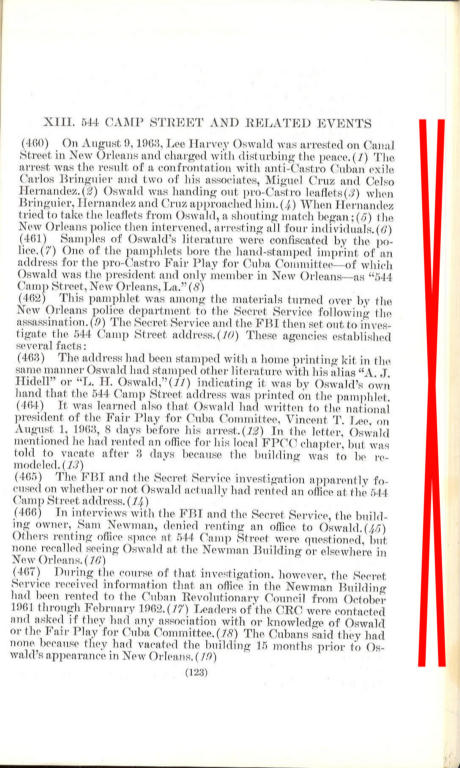
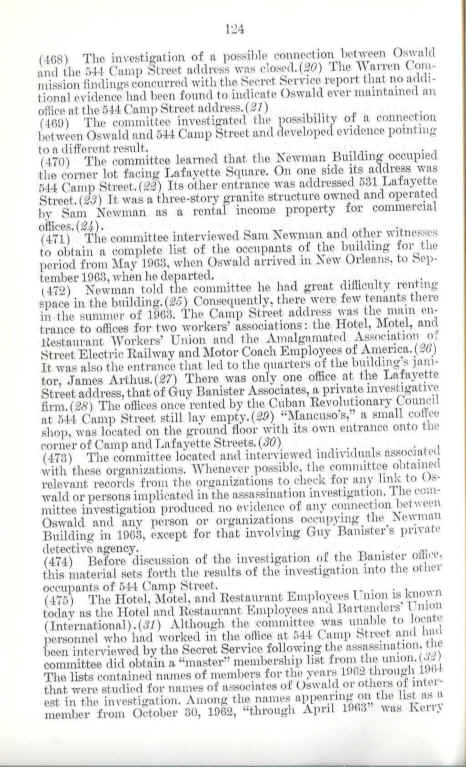
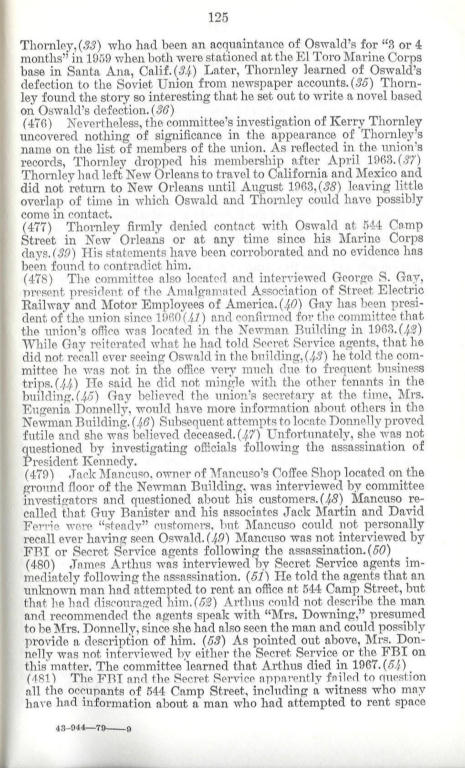
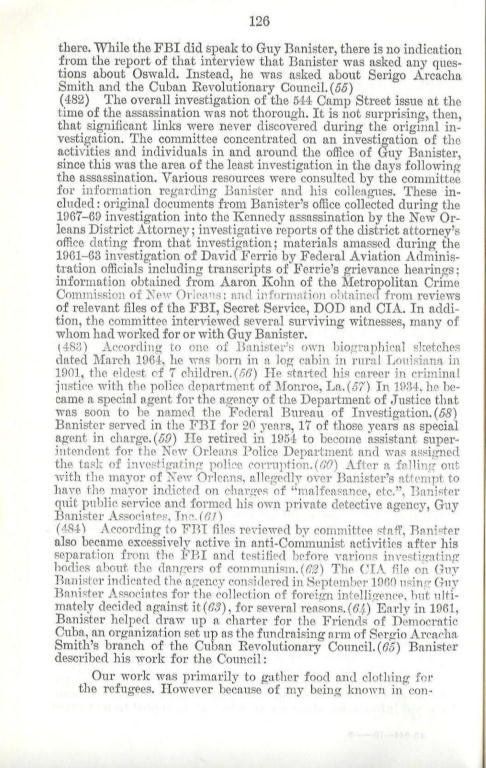
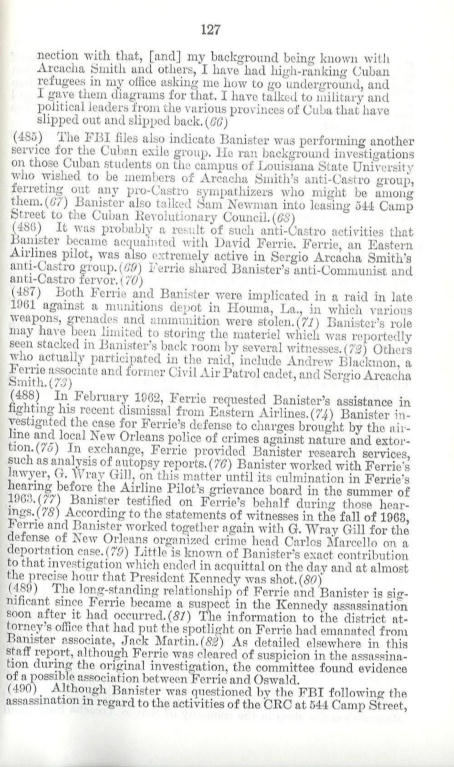
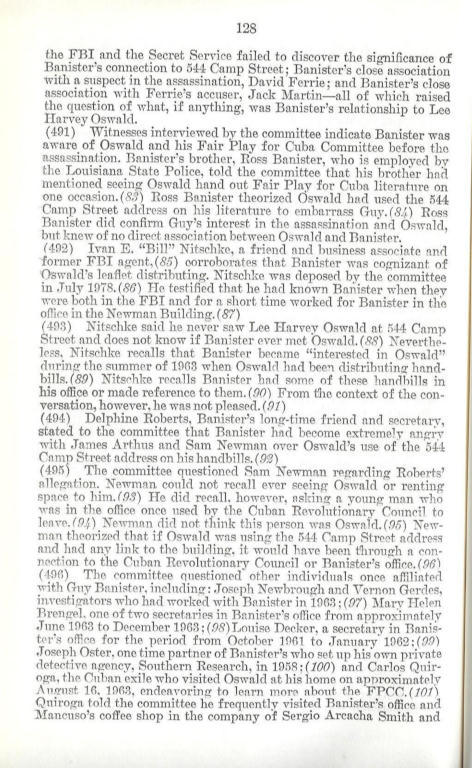
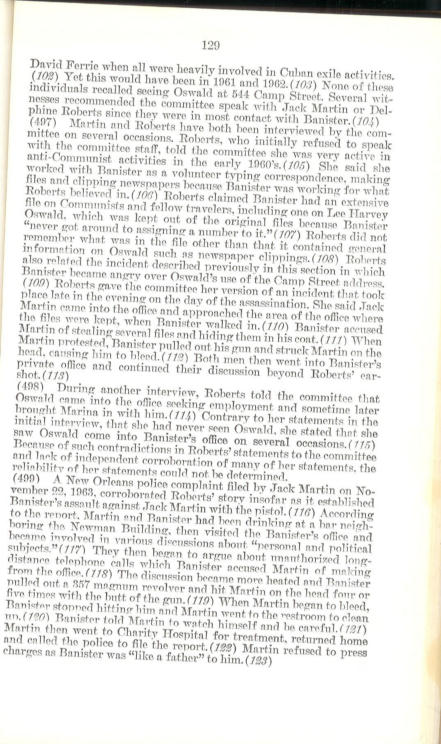
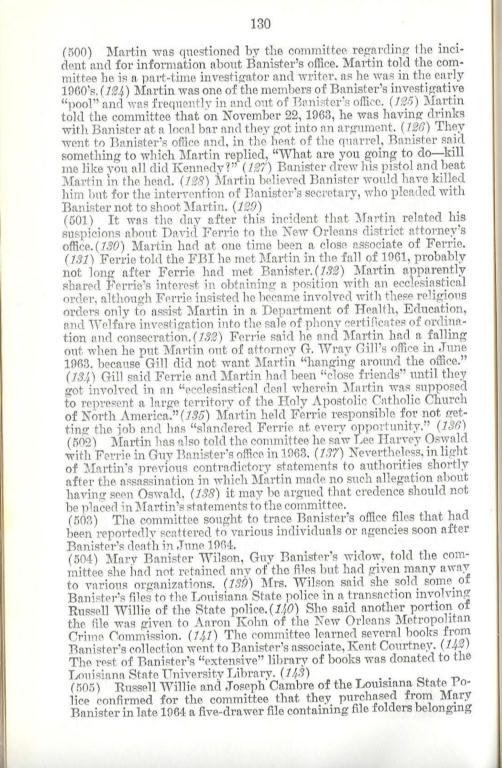
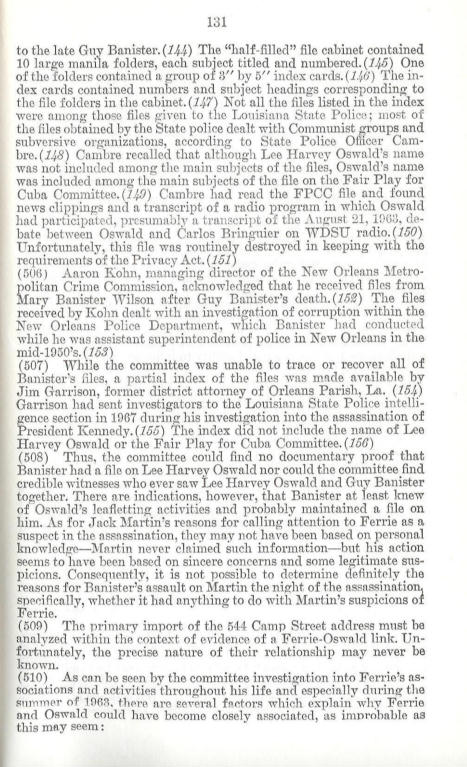
POSNER (p. 141): "There simply
is no credible evidence that Oswald ever had an office at
"Oswald worked for
Banister." .
LHO-BANNISTER
Kurtz may
have included his account in his earlier Lousiana History
article. In the book he tends to avoid using himself as a
witness,
perhaps feeling there was already enough evidence tying
Oswald and
Banister (hardly an "explosive" claim by 1982), but
he added the account
in his introduction to the paperback edition.
I don't
know if Andrews is credible or not. He may be on some things.
Banister/Leaflets:
Hinckle and Turner report that widow Mary
Banister, gathering up Guy's effects at
found a "large stack" of Fair Play leaflets.
Delphine Roberts, who knew
Banister's office as well as anyone (being his secretary and
mistress),
told Anthony Summers that Fair Play leaflets were kept in an
office
upstairs from the regular office, as Banister didn't want
them in his
normal business office. Her daughter confirmed that Oswald
had an office
there where he kept political literature. Summers says Andrew
Sciambra's
interview of Mary Banister indicated she found "a number
of" the
leaflets.
However
many leaflets Banister had, it's ludicrous to continue to
act as though no Banister-Oswald connection has been proven.
Here is a
summary of the evidence:
1.
Oswald's leaflets were stamped "
building in which Banister's office was housed. Posner
correctly notes
that Sam Newman, the building's owner, told the FBI he never
rented to
Oswald (HSCA X p. 123). This avoids the question of whether
someone else
rented an office for him, which is what might be expected if
Oswald was
working for Banister.
2.
The testimony of Jack Martin, who said he saw Oswald with David
Ferrie in Banister's
office in 1963 (HSCA X p. 130). He was a not
particularly reliable drunk who worked as an investigator for
Banister.
Sam Newman told HSCA that Martin was in Banister's office
"90 percent of
the time; every day almost" and he "kept up with
all that stuff."(HSCA X
p. 135, note 104)
3.
The testimony of Delphine Roberts, Banister's secretary and
mistress,
that Banister
kept a file on Oswald that "was kept out of the original
files" (the
FPCC and Oswald: HSCA X p. 131),
that Banister was angry Oswald stamped
several occasions."(HSCA X p. 129) She also said
Banister told her, when
she reported Oswald's leafletting to him, that "He's
with us. He's
associated with the office." (Anthony Summers,
Conspiracy, 1991 ed., p.
295) Posner notes that she is extreme right-wing, a religious
nut and
was paid for her interview with Anthony Summers (pp. 140-41),
none of
which proves she was lying. Banister friend and associate
Ivan Nitschke
told HSCA:"If you were trying to explore this to the
fullest extent, I
would say that Delphine would be No. 1."(HSCA X p. 135,
note 104).
Roberts told Summers Oswald worked for Banister. (Conspiracy,
op. cit.,
pp. 294-5).
PLUS:
1.
James Arthus' statement to the Secret Service that a man whose
name he didn't recall had tried to rent an office at
(HSCA X p. 125); he gave them the name of the woman who had
dealt with
the man, but she was never questioned. (Just as Banister was
never asked
about Oswald.)
2.
The statement of Ross Banister, Guy's brother, that he knew Guy
had an interest in Oswald, though he didn't think they were
connected
(HSCA X p. 128).
3.
The statement of Ivan Nitschke, the Banister friend and
associate, that Banister had some of Oswald's handbills in
his office
(HSCA X p. 128).
4.
Banister's widow Mary confirmed this to Andrew Sciambra of Jim
Garrison's office (Anthony Summers, Conspiracy, op. cit., p.
292). She
found a supply of the leaflets in her late husband's
storeroom (
Hinckle and William Turner, Deadly Secrets, p. 234).
5.
Banister employees Allen and Daniel Campbell. Daniel reported
that Oswald came into Banister's office and used the desk
phone. Allen
reports that instead of reacting with his usual anger at
pro-Castro
activities, Banister merely laughed when Oswald's leafletting
was
mentioned. (Conspiracy, op. cit., p. 293).
6.
Another young Banister employee, George Higginbothan, said he
kidded Banister "about sharing a building with people
papering the
streets with leftist literature." Banister
responded:"Cool it--one of
them is mine." (Hinckle and Turner, Deadly Secrets, pp.
234-5)
7.
Adrian Alba, whose office Oswald regularly visited, reported
seeing Oswald in Mancuso's restaurant, on the ground floor of
544 Camp
Banister. The restaurant's owner described Banister, David
Ferrie and
Jack Martin as regular customers.(HSCA X p. 125).
8.
CIA operative William George Gaudet reported seeing Oswald with
Banister. (Conspiracy op. cit., p. 444).
9.
Southern
Oswald and Banister twice visited the
together and engaged in heated discussions with students; he
was, at the
time, one of the students. He also saw the two together at
Mancuso's
(Kurtz, Crime of the Century, 1993 edition, p. 203, xxxix).
Witnesses he
interviewed for an earlier article reported seeing Oswald and
Banister
together at Mancuso's "with David Ferrie and Carlos
Quiroga"; Oswald was
seen entering Banister's office "several times";
one of Oswald's
co-workers at the Reily Coffee Co. saw Oswald and Banister
walking
together on
Citizens' Council meeting (reminiscent of the meetings Oswald
is known
to have attended in
A Reappraisal,"
10.
Another intriguing confirmation comes from Chuck Giancana,
brother of
that Banister was affiliated with the
Cross, p. 211) He was transferred to Marcello in
255), where the Chicago-affiliated roving Mob ambassador
Johnny Rosselli
kept in touch with him and approved his manipulation of
Oswald (ibid.,
pp. 332-3).
11.
Further confirmation comes from Through the Looking Glass: The
Mysterious World of Clay Shaw by William Davy:
Tommy Baumler, formerly an infiltrator of left-wing college
groups for
Banister, told interviewers in 1981 that "Oswald worked
for Banister."
HSCA VOLUME X CAMP ST.
1III. 544 CAMP STREET AND RELATED EVENTS
(460) On August 9, 1963, Lee Harvey Oswald was arrested on Canal
Street in New Orleans and charged with disturbing the peace . (1) The
arrest was the result of a confrontation with anti-Castro Cuban exile
Carlos Bringuier and two of his associates, Miguel Cruz and Celso
Hernandez.(2) Oswald was handing out pro-Castro leaflets (3) when
Bringuier, Hernandez and Cruz approached him. (4) When Hernandez
tried to take the leaflets from Oswald, a shouting match began ; (5) the
New Orleans police then intervened, arresting all four individuals. (6)
(461) Samples of Oswald's literature were confiscated by the police.
(7) One of the pamphlets bore the hand-stamped imprint of an
address for the pro-Castro Fair Play for Cuba Committee-of which
Oswald was the president and only member in New Orleans-as "544
Camp Street, New Orleans, La." (8)
(462) This pamphlet was among the materials turned over by the
New Orleans police department to the Secret Service following the
assassination. (9) The Secret Service and theFBI then set out to investigate
the 544 Camp Street address. (10) These agencies established
several facts :
(463) The address had been stamped with a home printing kit in the
same manner Oswald had stamped other literature with his alias "A. J.
Hidell" or "L. H. Oswald,"(11) indicating it was by Oswald's own
hand that the 544 Camp Street address was printed on the pamphlet.
(464) It was learned also that Oswald had written to the national
president of the Fair Play for Cuba Committee, Vincent T. Lee, on
August 1, 1963, 8 days before his arrest.(12) In the letter, Oswald
mentioned he had rented an office for his local FPCC chapter, but was
told to vacate after 3 days because the building was to be remodeled.
(13)
(465) The FBI and the Secret Service investigation apparently focused
on whether or not Oswald actually had rented an office at the 544
Camp Street address. (14)
(466) In interviews with the FBI and the Secret Service, the building
owner, Sam Newman, denied renting an office to Oswald. ( .41 .5)
Others renting office space at 544 Camp Street were questioned, but
none recalled seeing Oswald at the Newman Building or elsewhere in
New Orleans. (16)
(467) During the course of that investigation, however, the Secret
Service received information that an office in the Newman Building
had been rented to the Cuban Revolutionary Council from October
1961 through February 1962.(17) Leaders of the CRC were contacted
and asked if they had any association with or knowledge of Oswald
or the Fair Play for Cuba Committee. (18) The Cubans said they had
none because they had vacated the building 15 months prior to Oswald's
appearance in New Orleans. (19)
(123)
124
(466) The investigation of a possible connection between Oswald
and the 544 Camp Street address was closed . (20) The 1'Varren Coinmission
findings concurred with the Secret Service report that no addit
ional evidence had been found to indicate Oswald ever maintained an
office at the 544 Camp Street address. (21)
(469) The committee investigated the possibility of a connection
between Oswald and 544 Camp Street and developed evidence pointing
to a different result .
(470) The committee learned that the Newman Building occupied
the corner lot facing Lafayette Square . On one side its address was
44 Camp Street . (22) Its other entrance was addressed 531 Lafayette
Street . (23) It was a three-story granite structure owned and operated
by Sam Newman as a rental income property for commercial
offices. (24) .
(471) The committee interviewed Sam Newman and other witnesses
to obtain a complete list of the occupants of the building for the
period from May 1963. when Oswald arrived in New Orleans, to September
1963, when he departed .
(472) Newman told the committee he had great difficulty renting
space in the building. (2-5) Consequently, there were few tenants there
in the summer of 1963. The Camp Street address was the main entrance
to offices for two workers' associations : the Hotel, Motel, and
Restaurant Workers' Union and the Amalgamated Association of
street Electric Railway and Motor Coach Employees of America. (26)
It was also the entrance that led to the quarters of the building's janitor,
James Arthus . (2i) There was only one office at the Lafayette
Street address, that of Guy Banister Associates, a private investigative
firm. (28) The offices once rented by the Cuban Revolutionary Council
at 544 Camp Street still lay empty. (29) "Mancuso's," a small coffee
shop, was located on the ground floor with its own entrance onto the
corner of Camp and Lafayette Streets. (30)
(473) The committee located and interviewed individuals associated
with these organizations. Whenever possible, the committee obtained
relevant records from the organizations to check for any link to Oswald
or persons implicated in the assassination investigation. Thecommittee
investigation produced no evidence of any connection between
Oswald and any person or organizations occupying the Newman
Building in 1963, except for that involving Guy Banister's private
detective agency.
(474) Before discussion of the investigation of the Banister office,
this material sets forth the results of the investigation into the other
occupants of 544 Camp Street .
(475) The Hotel, Motel, and Restaurant Employees Union is known
today as the Hotel and Restaurant Employees and Bartenders' Union
(International) . (31) Although the committee was unable to locate
personnel who had worked in the office at 544 Camp Street and had
been interviewed by the Secret Service following the assassination, the
committee did obtain a "master" membership list from the union. (32)
The lists contained names of members for the years 1962 through 1964
that were studied for names of associates of Oswald or others of interest
in the investigation. Among the names appearing on the list as it
member from October 30, 1962, "through April 1963" was Kerry
125
Thornley,(33) who had been an acquaintance of Oswald's for "3 or 4
months" in 1959 when both were stationed at the El Toro Marine Corps
base in Santa Ana, Calif. (34) Later, Thornley learned of Oswald's
defection to the Soviet Union from newspaper accounts. (35) Thornley
found the story so interesting that he set out to write a novel based
on Oswald's defection. (36)
(476) Nevertheless, the committee's investigation of Kerry Thornley
uncovered nothing of significance in the appearance name of Thornley's on the list of members of the union. As reflected in the union's
records, Thornley dropped his membership after April 1963. (37)
Thornley had left New Orleans to travel to California and Mexico and
did not return to New Orleans until August 1963,(38) leaving little
overlap of time in which Oswald and Thornley could have possibly
come in contact.
(477) Thornley firmly denied contact with Oswald at 544 Camp
Street in New Orleans or at any time since his Marine Corps
days. (39) His statements have been corroborated and no evidence has
been found to contradict him.
(478) The committee also located and interviewed George S. Gay,
present preeident of the Amalgamated Association of Street Electric
Railway and Motor Employees of America. (40) Gay has been president
of the union since 1:M0 (.,1r1) and confirmed for the committee that
the union's office was located in the Newman Building in 1963. (1r2) While Gay reiterated what he had told Secret Service agents, that he
did not recall ever seeing Oswald in the building, (.l3) he told the committee
he was not in the office very much due to frequent business
trips.(44) He said he did not mingle with the other tenants in the
building. (4.5) Gay believed the union's secretary at the time, Mrs.
Eugenia Donnelly, would have more information about others in the
Newman Building . (.46) Subsequent attempts to locate Donnelly proved
futile and she was believed deceased. (1,7) Unfortunately, she was not
questioned by investigating officials following the assassination of
President Kennedy.
(479) Tack Mancuso, owner of Mancuso's Coffee Shop located on the
ground floor of the Newman Building, was interviewed by committee
investigators and questioned about his customers. (.48) Mancuso recalled
that Guy Banister and his associates Jack Martin and David
Ferrie were "steady" customers, but Mancuso could not personally
recall ever having seen Oswald. (a,9) Mancuso was not interviewed by
FBI or Secret Service agents following the assassination. (50)
(480) James Arthus was interviewed by Secret Service agents im- mediately following the assassination. (51) He told the agents that an
unknown man had attempted to rent an office at 544 Camp Street, but
that he had discouraged him. (52) Arthus could not describe the man
and recommended the agents speak with "Mrs. Downing," presumed
to be Mrs. Donnelly, since she had also seen the man and could possibly
provide a description of him. (53) As pointed out above, Mrs. Donnelly
was not interviewed by either the Secret Service or the FBI on
this matter . The committee learned that Arthus died in 1967. (51.)
(481) The FBI and the Secret Service apparently failed to apuestion
all the occupants of 544 Camp Street, including a witness who may
have had information about a man who had attempted to rent space
43-944-79-9
12 6
there. While the FBI did speak to GuyBanister, there is no indication
from the report of that interview that Banister was asked any questions
about Oswald. Instead, he was asked about Serigo Arcacha
Smith and the Cuban Revolutionary Council. (55)
(482) The overall investigation of the 544 Camp Street issue at the
time of the assassination was not thorough. It is not surprising, then,
that significant links were never discovered during the original investigation.
The committee concentrated on an investigation of the
activities and individuals in and around the office of Guy Banister,
since this was the area of the least investigation in the days following
the assassination. Various resources were consulted by the committee
for information regarding Banister and his colleagues. These included
: original documents from Banister's office collected during the
1967-69 investigation into the Kennedy assassination by the New Orleans
District Attorney ; investigative reports of the district attorney's
office dating from that investigation ; materials amassed during the
1961-63 investigation of David Ferric by Federal Aviation Administration
officials including transcripts of Ferrie's grievance hearings :
information obtained from Aaron Kohn of the Metropolitan Crime
Commission of \ev- Orlewis : and information obtained from reviews
of relevant files of the FBI, Secret Service, DOD and CIA. In addition,
the committee interviewed several surviving witnesses, many of
whom had worked for or with GuyBanister.
X483) According to one of Banister's own biographical sketches
dated March 1964, he was born in a log cabin in rural Louisiana in
1901, the eldest of 7 children.(56) He started his career in criminal
justice with the police department of Monroe, La. (57) In 1934, he became
a special agent for the agency of the Department of Justice that
was soon to be named the Federal Bureau of Investigation. (58)
Banister served in the FBI for 20 years, 17 of those years as special
agent in charge . (59) He retired in 1954 to become assistant superintendent
for the New Orleans Police Department and was assigned
the task of investi_-atin;!~, police corruption .(6(1) After a fallinm out
with the mayor of 'Yew Orleans, allegedly over Banister's attempt to
have the mayor indicted on charges of "malfeasance, etc.", Banister
quit public service and formed his own private detective agency, Guy
Banister Associates, Inc. (61)
(484) According to FBI files reviewed by committee staff, Banister
also became excessively active in anti-Communist activities after his
separation from the FBI and testified before various investigating
bodies abort the dangers of communism. (62) The CIA file on Guy
Banister indicated the agency considered in September 1960 r1sing Guy
Banister Associates for the collection of foreign intelligence, but ultimately
decided against it (63), for several reasons. (6l4) Early in 1961,
Banister helped draw up a charter for the Friends of Democratic
Cuba, an organization set up as the fundraising arm of Sergio Arcacha
Smith's branch of the Cuban Revolutionary Council. (65) Banister
described his work for the Council
Our work was primarily to gather food and clothing for
the refugees. However because of my being known in con127
nection with that, [and] my background being known with
Arcacha Smith and others, I have had high-ranking Cuban
refugees in my office asking me how to go underground, and
I gave them diagrams for that. I have talked to military and
political leaders from the various provinces of Cuba that have
slipped out and slipped back. (66)
(485) The FBI files also indicate Banister was performing another
service for the Cuban exile group. IIe ran background investigations
on those Cuban students on the cainpus of Louisiana State lJniversitv
n-lio wished to be ineml)ers of Arcacha Smith's anti-Castro group,
ferreting out any pro-Castro sympathizers who might be among
them. (G''~) Banister also talked Sam NeĢ-man into leasing 544 Camp
Street to the Cuban Revolutionary Council. (68)~~
(486) It was probably a result of such anti-Castro activities that
Banister became acquainted i~ith David Ferrie . Ferrie, an Eastern
Airlines pilot, was also extreinely active in Sergio Arcacha Smith's
anti-Castro group. (69) Ferric shared Banister's anti-Communist and
anti-Castro fervor. (70)
(487) Both Ferric and Banister were implicated in a raid in late
1961 against a mu;iitions depot in l:Iotuna, La., in which varioi :s
weapons, grenades and zinmtmition were stolein.(71) Banister's role
may have been limited to storing the materiel which was reportedly
seen stacked in Banister's back room by several witnesses. (72) Others
who actually participated in the raid, include Andrew Blackmon, a
Ferric associate and foriner C1C11 Air Patrol cadet, and Sergio Arcacha
Sjnith .(73)
(488) In February 1962, Ferrie requested Banister's assistance in
fighting his recent dismissal from Eastern Airlines . (74) Banister investigated
the case for Ferrie's defense to charges brought by the airline
and local New Orleans police of crimes against nature and extoition.
(75) In exchange, Ferrie provided Banister research services,
such as analysis of autopsy reports. (76) Banister worked with Ferrie's
lawyer, G. 11'ray Gill, on this matter until its culmination in Ferrie's
hearing before the Airline Pilot's grievance board in the summer of
1963. (77) Banister testified on Ferrie's behalf during those hearings.
(78) According to the statements of witnesses in the fall of 1963,
Ferrie and Banister worked together again with G. gray Gill for the
defense of New Orleans organized crime head Carlos Dlarcello on a
deportation case. (79) Little is known of Banister's exact contribution
to that investigation which ended in acquittal on the day and at almost
the precise hour that President Kennedy was shot. (80)
(489) The long-standing relationship of Ferric and Banister is significant
since Ferrie became a suspect in the Kennedy assassination
soon after it had occurred. (81) The information to the district attorney's
office that had put the spotlight on Ferric had emanated from
Banister associate, Jack Dlartin.(82) As detailed elsewhere in this
staff report, although Ferric was cleared of suspicion in the assassination
during the original investigation, the committee found evidence
of a possible association between Ferrie and Oswald.
(490) Although Banister was questioned by the FBi following the
assassination in regard to the activities of the CRC at 544 Camp Street,
128
the FBI and the Secret Service failed to discover the significance of
Banister's connection to 544 Camp Street ; Banister's close association
with a suspect in the assassination, David Ferrie ; and Banister's close
association with Ferrie's accuser, Jack Martin-all of which raised
the question of what, if anything, was Banister's relationship to Lee
Harvey Oswald.
(491) Witnesses interviewed by the committee indicate Banister was
aware of Oswald and his Fair Play for Cuba Committee before the
assassination . Banister's brother, Ross Banister, who is employed by
the Louisiana State Police, told the committee that his brother had
mentioned seeing Oswald hand out Fair Play for Cuba literature on
one occasion. (83) Ross Banister theorized Oswald had used the 544
Camp Street address on his literature to embarrass Guy.(&_) Ross
Banister did confirm Guy's interest in the assassination and Osivald,
but knew of no direct association between Oswald and Banister.
(492) Ivan F. "Bill" Nitschke, a friend and business associate and
former FBI agent, (85) corroborates that Banister was cognizant of
Oswald's leaflet distributing. Nitschke was deposed by the committee
in July 1978. (86) He testified that he had known Banister when they
were both in the FBI and for a short time worked for Banister in tho
o{lice in theNewman Building. (87)
(493) Nitschke said he never saw Lee Harvey Oswald at 5-'44 Camp
Street and does not know if Banister ever met Oswald. (88) Nevertheless.
Nitschke recalls that Banister became "interested in Oswald"
during the summer of 1963 when Oswald had been distributing handbills.
(89) Nitschke recalls Banister had some of these handbills in
his office or made reference to them. (90) From the context of the conversation,
however, he was not pleased. (91)
(494) Delphine Roberts, Banister's long-time friend and secretary,
stated to the committee that Banister had become extremely angry
with James Arthus and Sam Newman over Oswald's use of the 544
Camp Street address on his handbills. (92)
(495) The committee questioned Sam Newman regarding Roberts'
allegation. Newman could not recall ever seeing Oswald or renting
space, to him. (93) He did recall . however, asking a young man who
was in the office once used by the Cuban Revolutionary Council to
leave. (9l) Newman did not thin'.; this person was Oswald. (95) Newman
theorized that if Oswald was using the 544 Camp Street address
and had any link to the building, it would have been through a connection
to the Cuban Revolutionary Council or Banister's office . (96)
(496) The committee questioned other individuals once affiliated
with Guy Banister, including : Joseph Newbrough and Vernon Gerdes,
investigators who had worked with Banister in 1963 ; (97) Marv Helen
Brengel, one of two secretaries in Banister's office from approximately
June 1963 to December 1963 ; (98) Louise Decker, a secretary in Banister's
office for the period from October 1961 to January 1962 ; (99)
Joseph Oster, one time partner of Banister's who set up his own private
detective agency, Southern Research, in 1958 ; (100) and Carlos Quiroga,
the Cuban exile who visited Oswald at his home on approximately
An.snist 16, 1963, endeavoring to learn more about the FPCC. (101)
(luiroga told the committee he frequently visited Banister's office and
Mancuso's coffee shop in the company of Sergio Arcacha Smith and
129
David Ferrie when all were heavily involved in Cuban exile activities .
(10°2) Yet this would have been in 1961 and 1962.(10 .:) None of these
individuals recalled seeing Oswald at 544 Camp Street. Several witnesses
recommended the committee speak with Jack Martin or Delphine
Roberts since they were in most contact with Banister . (10_F)
(497) Martin and Roberts have both been interviewed by the committee
on several occasions. Roberts, who initially refused to speak
with the committee staff, told the committee she was very active in
anti-Communist activities in the e-,rly 1960's.(10,5) She said she
worked with Banister as a volunteer typing correspondence, making
files and clipping newspapers because Banister was worl:inn fo,- -what
Roberts believed in . (10(7) Roberts claimed Banister had an extensive
file on Communists and fellow travelers, including one on Lee Harvey
Oswald, which was kept out of the original files because Banister
"never got around to assigning a number to it."(107) Roberts did not
remember what was in the file other than that it contained general
information on Oswald such as newspaper clippings.(108) Rollerts
also related the incident described previolusly in this section in which
Banister became angry over Oswald's use of the Camp Street address.
(10<9) Robertq gave the committee her version of an incident that took
place late in the evening on the day of the assassination. She said Jack
Martin came into the office and approached the area of the office where
the files were kept, when Banister walked in .(110) Banister accused
7kTartin of stealing several files and hiding them in his coat. (111) When
Martin protested, Banister pulled out his minandstruck Martin on the
head, ca?us~ng lug to bleed.(11~) Both men then went into Banister's
private office and continued their discussion beyond Roberts' earshot,
(113)
(494) During another interview, Roberts told the committee that
Oswald came into the office seeking employment and sometime later
bronmllt Marina in with him.(114) Contrary to her statements in the
initial interview, that she had never seen Oswald. she stated that she
saw Oswald come into Banister's office on several occasions. (115)
Because of such con+radictions in Roberts' statements to the committee
and lack of independent corroboration of many of her statements, the
reli9bility of her statements could not be determined.
(499) A_ New Orleans police complaint filed by Jack Martin on November
22, 1963, corroborated Roberts' storv insofar as it established
Banister's assault against Ja ck 1flartin with the pistol . (116) According
to the renort . Martin and Banister had been drinking at a bar nei?hborinrr
the Newman Building, then visited the Banister's office and
became involved in various discussions about "personal and political
snbiects."(117) Thev then began to argue about unanthori7ed longdistance,
telephone calls which Banister accused Martin of malting
from the office . (118) The discussion became more heated and Banister
pulled out a 357 magnum revolver and hit Martin on the head four or
five times with the butt of the gum. (119) When Martin began to bleed,
B,ni-t-r stopped hitting him and Martin went to the restroom to clean
Tern . (1??0) Banister told Martin to watch himself and be careful. (121)
11Tgrtin then went to Charity Hospital for treatment, returned home
and called the police to file the report. (1°2°2) Martin refused to press
charges as Banister was "like a father" to him. (1°23)
130
(500) Martin was questioned by the committee regarding the incident
and for information about Banister's office . Martin told the committee
he is a part-time investigator and writer . as he was in the early
1960's . (121) Martin was one of the members of Banister's investigative
"pool" and was frequently in and out of Banister's office . (125) Martin
told the committee that on November 22, 1963, he was having drinks
with Banister at a local bar and they got into an argument, (126) Thev
went, to BanistWs office and, in the bent, of the quarrel, Banister said
something to which Martin replied, "'"That are you going to do-kill
me like you all did Kennedy?" (12,') Banister drew his pistol and beat
Martin in the head. (_7 ?8) 11artin believed Banister would have killed
him but for the intervention of Banister's secretary, who pleaded with
Banister not to shoot -Martin. (129)
(501) It was the day after this incident that -Martin related his
suspicions about David Ferrie to the New Orleans district attorney's
office . (130) Martin had at one time been a close associate of Ferric.
(131) Ferrie told the FBI he met -Martin in the fall of 1961, probably
not long after Ferrie had met Banister. (132) Martin apparently
shared b'errie's interest in obtaining a position with an ecclesiastical
order, although Ferric insisted he became involved with these religions
orders only to assist Martin in a Department of Health, Education,
and Welfare investigation into the sale of phony certificates of ordination
and consecration .(132) Ferric said he and -Martin had a falling
out, when he put -Martin out of attorney G. Wray Gill's office in June
1963. because Gill did not want Martin "hanging around the office ."
(13!x) Gill said Ferrie and Martin had been "close friends" until they
got involved in an "ecclesiastical deal wherein 'Martin was supposed
to represent a large territory of the Holy Apostolic Catholic Church
of North America."(135) Martin held Ferrie responsible for not getting
the Job and has "slandered Ferrie at every opportunity." (136)
(502) Martin has also told the committee he caw Lee Harvey Oswald
with Ferrie in Guy Banister's office in 1963. (1.37) Nevertheless, in light
of -Martin's previous contradictory statements to authorities shortly
after the assassination in which Martin made no such allegation about
having seen Oswald, (138) it may be argued that credence should not
be placed in Martin's statements to the committee.
(503) The committee sought to trace Banister's office files that had
been reportedly scattered to various individuals or agencies soon after
Banister's death in June 1964.
(504) Mary Banister Wilson, Guy Banister's widow, told the committee
she had not retained any of the files but had given many away
to various organizations . (139) -Mrs. Wilson said she sold some of
Banister's files to the Louisiana State police in a transaction involving
Russell Willie of the State police .(140) She said another portion of
the file was given to Aaron Kohn of the New Orleans Metropolitan
Crime Commission. (141) The committee learned several books from
Banister's collection went to Banister's associate, Kent Courtney. (142)
The rest of Banister's "extensive" librarv of books was donated to the
Louisiana State University Library. (1.~3)
(505) Russell Willie and Joseph Cambre of the Louisiana State Police
confirmed for the committee that they purchased from Mary
Banister in late 1964 a five-drawer file containing file folders belonging
to the late Guy Banister. (14!x) The "half-filled" file cabinet contained
10 large manila folders, each subject titled and numbered. (145) One
of the folders contained a group of 3" by 5" index cards. (116) The index
cards contained numbers and subject headings corresponding to
the file folders in the cabinet. (147) Not all the files listed in the index
were among those files given to the Louisiana State Police ; most of
the files obtained by the State police dealt with Communist groups and
subversive organizations, according to State Police Officer Cambre.
(148) Cambre recalled that although Lee Harvey Oswald's name
was not included among the main subjects of the files, Oswald's name
was included among the main subjects of the file on the Fair Play for
Cuba Committee. (1419) Cambre had read the FPCC file and found
news clippings and a transcript of a radio program in which Oswald
had participated, presumably a transcript of the Augrnst 21, 1963, debate
between Oswald and Carlos Bringuier on WDSU radio. (150)
Unfortunately, this file was routinely destroyed in keeping with the
requirements of the Privacy Act. (151)
(506) Aaron Kohn, managing director of the New Orleans Metropolitan
Crime Commission, acknowledged that he received files from
Mary Banister Wilson after Guy Banister's death. (152) The files
received by Kohn dealt with an investigation of corruption within the
New Orleans Police Department, which Banister had conducted
while he was assistant superintendent of police in New Orleans in the
mid-1950'x . (153)
(507) While the committee was unable to trace or recover all of
Banister's files, a partial index of the files was made available by
Jim Garrison, former district attorney of Orleans Parish, La. (15.x)
Garrison had sent investigators to the Louisiana State Police intelligence
section in 1967 during his investigation into the assassination of
President Kennedy. (155) The index did not include the name of Lee
Harvey Oswald or the Fair Play for Cuba Committee. (156)
(508) Thus, the committee could find no documentary proof that
Banister had a file on Lee Harvey Oswald nor could the committee find
credible witnesses whoever saw Lee Harvey Oswald and Guy Banister
together. There are indications, however, that Banister at least knew
of Oswald's leafletting activities and probably maintained a file on
him. As for Jack Martin's reasons for calling attention to Ferric as a
suspect in the assassination, they may not have been based on personal
knowledge-Martin never claimed such information-but his action
seems to have been based on sincere concerns and some legitimate suspicions.
Consequently, it is not possible to determine definitely the
reasons for Banister's assault on Martin the night of the assassination,
specifically, whether it had anything to do with Martin's suspicions of
Ferric .
(509) The primary import of the 544 Camp Street address must be
analyzed within the contest of evidence of a Ferric-Oswald link. Unfortunately,
the precise nature of their relationship may never be
known.
(510) As can be seen by the committee investigation into Ferrie's associations
and activities throughout his life and especially during the
summer of 1963 . there are several factors which explain why Ferric
and Oswald could have become closely associated, as improbable as
this may seem
(511) A. Both men spent considerable time in the same locale : Ferrie
frequently visited the office of Guy Banister in the building at 544
Camp Street ;* Oswald worked only one block away and had used 544
Camp Street as the address of the Fair Play for Cuba Committee. Additionally,
the testimony of a number of witnesses from Clinton, La.,
placing Oswald and Ferrie together in early September 1963, may be
credible . Evidence also exists to support the belief that a Ferrie colleague,
Guy Banister, knew Oswald's pro-Castro leafletting.
(512) B. Both men had similar, fervent interest in political topics,
especially the Cuban question. Although Ferrie stood firmly on the
anti-Castro side of the issue and Oswald was involved in pro-Castro
activities, this alone would not rule out the possibility of an Oswald-
Fe-rrie association.
(513) Oswald, on at least one occasion, made a friendly overture
to a known anti-Castro activist, Carlos Bringuier, the New Orleans
delegate to the Student Revolutionary Directorate (DRE)
and even offered Bringuier assistance in military training of Cuban
exiles . The Oswald-Ferrie association may have begun in the same
manner.
(514) C. Significant to the argument that Oswald and Ferrie were
associated in 1963 is evidence of prior association in 19,55 when Ferrie
was captain of a Civil Air Patrol squadron and Oswald a young cadet.
This pupil-teacher relationship could have greatly facilitated their reacquaintance
and Ferrie's noted ability to influence others could have
been used with Oswald.
(515) D. Ferrie's experience with the underground activities of the
Cuban exile movement and as a private investigator for Carlos
Marcello and Guy Banister might have made him a good candidate
to participate in a conspiracy plot. He may not have known what was
to be the outcome of his actions, but once the assassination had been
successfully completed and his own name cleared, Ferrie. would have
had no reason to reveal his knowledge of the plot. Further, fear for
his life may have prevented himfrom doing so.
(516) While it could not be definitely determined whether Ferrie
had any contact with Oswald after Oswald left New Orleans on
September 24, 1963, until the day of the assassination only 2 months
later, the possible Oswald-Ferrie relationship is a significant Oswald
association.
Submitted by
132
GAETON J. FONZI
Investigator.
PATRICIA M. ORR
Researcher.
*Strangely, although Ferrie seemed to be straightforward during his interviews
with FBI agents in discussing his opposition to Kennedy, his conflict
with Jack Martin, his involvement in the Marcello case, et cetera, Ferrie denied
outright that he had ever known "of the Cuban Revolutionary Front maintaining
an office at 544 Camp Street, nor does he have any knowledge of Sergio Arcacha
Smith maintaining an office at that address during the time he was head of the
organization and later after he was replaced." (157) This is clearly in contradiction
to the accounts of the witnesses on this subject.
133
REFERENCES
(1) Report of the President's Commission on the Assassination of President
Kennedy (Washington, D.C . : U.S. Government Printing Office, 1964), p . 728
(hereinafter cited as the Warren Report) .
(2) Ibid .
(3) Hearings before the President's Commission on the Assassination of President
Kennedy (Washington, D.C. : U.S . Government Printing Office, 1964), vol.
XXVI, CE--2966 A and B (hereinafter cited as Warren Commission Hearings) .
( .~) Warren Report, p . 728 ; Deposition of Carlos Bringnier, May 12, 1978,
House Select Committee on Assassinations, pp. 126-129 (J. F. K. Document
009084) .
(5) Ibid .
(6) Warren Report, p . 826 .
(7) Ibid .
(8) XXVI, Warren Commission Hearings, p. 30, CE-3120, Pamphlet, "The
Crime Against Cuba," Corliss Lamont.
(9) Ibid ., vol . XXVI, p . 11, CE-3119, Secret Service Report, Nov. 30, 1963,
CO-2-34 .030 .
(10) Ibid . ; FBI teletype, FOIA materials, 62-109060-1668, Nov. 26, 1963,
pp. 1-3 .
(11) XXVI, Warren Commission Hearings, CE-2966 A and B.
(12) Ibid., vol. XX, Lee DE-7.
(13) Ibid.
(14) Warren Report, p . 408 ; XXII, Warren Commission Hearings, CE-1414 ;
FBI teletype, FOIA materials, 62-109060-1668, Nov. 26, 1963, pp. 1-3 .
(15) Did. ; XXII, Warren Commission Hearings, CE-1414.
(16) Ibid .
(17) Ibid .
(18) Ibid .
(19) Ibid .
(20) Ibid. ; FBI teletype, FOIA materials, 62-109060-1668, Nov. 26,1963, pp. 1-a
QI) Warren Report, pp. 292 and 408 .
(22) Deposition of Sam Newman, Nov. 6, 1978, House Select Committee on
Assassinations, p. 21 (J . F. K. Document 014020) .
(23) Ibid .
(2/F ) Id . a t p . 5 .
(25) Id . a t p . 22 .
(26) XXII, Warren Commission Hearings, CE-1414, Secret Service Report,
CO-2-34,030 . pp. 4-5.
(27) See ref . 22 .
(28) Id . a t pp. 9,21 .
(29) Td . i t pp. 23-24 .
(°0) Id . a t p. 13.
(31) Outside Contact Report with Attachment, Mrs. Anna Stewart, Apr. 11,
1978, House Select Committee on Assassinations (J. F. K. Document 007364) .
(32) Ibid., attachments : Rosters through October 1962, April 1963 and March
1964.
(33) Ibid ., roster through October 1962, p. 14 (first list) ; roster through April
1963, p. 16 (second list) .
(3l,) FBI teletype, FOIA material, 62-109060-1668, Nov. 26, 1963, p. 9 .
(35) Kerry Thornley affidavit, Jan. 8, 1976, p. 1, House Select Committee on
Assassinations (J. F. K. Document 012740) . (Note : This statement, while rambling
and confusing, remains consistent on the major point that Thornley had no
contact with Oswald after service in the Marines.)
(36) Ibid . : see also testimony of Kerry Thornley, May 18, 1964, XI, Warren
Commission Hearings, pp. 96-97.
(37) Outside Contact Report. Mrs. Anna Stewart, Apr. 11, 1978, House Select
Committee on Assassinations, attachment roster through March 1964 (J. F. X.
Document 007364) .
(38) FBI teletype, FOIA material, 62-109060-1668. Nov. 26, 1963, p. 9.
(39) Ibid. ; Secret Service Report, Dec. 2, 19639 CO-2-34,030 (J. F. K. Document
003675) : Thornley testimony, XI, Warren Commission Hearings, 110 .
(40) Outside Contact Report, George S . Gap, Jan. 13, 1978, House Select Committee
on Assassinations (J. F. K. Document 005191) .
134
(41) XXII, Warren Commission Hearings, CE-1414, Secret Service Report,
CO-2-34,030, Dec. 9, 1963, p. 5.
(12) Outside Contact Report, George C. Gap, Jan. 13, 1978, House Select Committee
on Assassinations (J . F. B. Document 005191) .
(43) Ibid . ; XXII, Warren Commission Hearings, CE-1414, Secret Service Report
. CO-2-34,030, Dec. 9, 1963, p. 5.
(44) See ref. 42.
(45) Ibid .
(46) Ibid .
(47) Outside Contact Report, George S. Gap, re : Eugenia Donnelly, June 6,
1978, House Select Committee on Assassinations (J.F .K. Document 009115) .
(1,8) Outside Contact Report, Jack 'Mancuso, Jan. 26, 1978, House Select Committee
on Assassinations (J. F. K. Document 014120) .
(19) Ibid .
(50) Ibid .
(51) XXVI, Warren Commission Hearings, CE-3119, Secret Service Report,
Nov. 30, 1963, CO-2-34,030, p. 15.
(52) Ibid .
(.5°) Ibid .
(54) Outside Contact Report, re : James Arthus. June 1, 1978, House Select
Committee on Assassinations (J. F. K. Document 009047) .
(55) FBI Teletype, FOIA material, 62-109060-2668, Nov. 26, 1963, p. 2.
(.56) Material received from files of New Orleans district attorney's office pertaining
to investigation and trial of Clay Shaw, 1967-69, attachment D, section 5,
regarding Guy Banister, "Biographical Sketch" (J . F. K. Document 007271) .
( .57) Ibid .
(58) Ibid .
1(59) Ibid .
(60) Ibid. : FAA materials. Systems Board of Adjustments Grievance Hearing
of David Ferrie, testimony of Guy Banister, Aug. 5, 1963, p. 828 (J . F. K. Document
No. 014904) .
(61) See ref. 56.
(62) Staff review of FBI files for Guy Banister, Oct. 28, 1978, pp. 1-2.
x(68) CIA document.
(64) Staff review of FBI files for Guy Banister, Oct. 28, 1978, pp. 1-2. (Note :
Coincidentally, Gerard F. Tujague, owner of Gerard F. Tujague, Inc. Forwarding
Co., who had employed Oswald as a messenger from November 1955 to January
1956, was also a member and officer (vice-president) of Friends of Democratic
Cuba (see FBI teletype, 62-10906.01668, Jan. 26, 1963, p. 5) .)
(65) Ibid .
I(66) See ref. 60, p. 828.
(67) Staff review of FBI files for Guy Banister, Oct. 28, 1978, pp. 1-2.
(68) Deposition of Sam Newman, Nov. 6, 1978, House Select Committee on
Assassinations, p. 22 (J . F. K. Document No. 014020) .
(69) Staff report, "Anti-Castro Activist and Organizations and Lee Harvey
Oswald in New Orleans," Appendix to the Hearings before the Select Committee
on Assassinations, House of Representatives, 95th Congress, 2d session (Washington,
D.C . : U.S . Government Printing Office, 1979), vol. X, par. 419fe (hereinafter
the Anti-Castro Cuban staff report) .
(70) Ibid., pars. 402 and 418.
(71) FBI teletype, FOIA material, 62-109060-5237, May 7, 1967, pp. 1-2.
(72) Outside Contact Report, Vernon Gerdes, Jan. 10, 1978, House Select Committee
on Assassinations, p. 3 (J. F. K. Document No. 005208) ; see ref. 68, p. 49 ;
Outside Contact Report, Jack Martin, Dec. 5, 1978, House Select Committee on
Assassinations, p. 6 (J . F. K. Document No. 005212) .
(73) FBI teletype, FOIA material, 62-109060-5237, May 7, 1967, pp. 1-2.
(74) See ref. 60, p. 825.
(75) Ibid ., p. 48L
(76) Ibid .
(77) Ibid .
(78) Ibid ., pp. 825-855.
1(79) Outside Contact Report, Mary Helen Brengel, Apr. 6, 197$ House Select
Committee on Assassinations (J. F. K. Document No. 008861) ; and ref. 69, Anti-
Castro Cuban Staff Report, par. 439ff.
(80) Ibid ., par. 390.
(81) Ibid ., par. 390ff.
(82) Ibid ., par. 392.
(8j) Outside Contact Report, Ross Banister, Feb. 20, 1978, House Select Committee
on Assassinations, p. 3 (J. F. K. Document No. 005967) .
(84) Ibid .
(85) Ibid .
(86) Deposition of I . E. "Bill" Nitschke, July 31, 1978, House Select Committee
on Assassinations, pp. 5 and 12 (J. F. K. Document No. 012308) .
(87) Id . a t pp. 12-14 .
(88) Id . a t pp. 3(i-37.
(89) Ibid.
(9(I) Id . a t pp.38-41.
(91) Ibid .
(92) Outside Contact Report, Delphine Roberts, July 6, 1978, House Select
Committee on Assassinations, p . 3 (J . F. K. Document No. 009979) .
(93) See ref . 22, p. 27.
(94) Id . a t pp. 35-36.
x(95) Ibid.
(96) Id . a t p. 30 .
(97) Outside contact report, Joseph Newbrough, Apr. 10, 1964, House Select
Committee on Assassinations, p . 1 (J . F. K. Document No. 009113) . Newbrough
was associated with Banister's agency from approximately 1958 to 1964 ; Outside
Contact Report, Vernon Gerdes, Jan. 10, 1978, House Select Committee on Assassinations
(J. F. K. Document No. 005208) . Gerdes was associated with Banister
for the period 1960-63.
(98) Outside contact report, Mary Helen Brengel, Apr. 6, 1978, House Select
Committee on Assassinations, p. 1 (J. F. K. Document No. 008861) .
(99) Notes of an interview of Louise Decker, May 30, 1978, House Select Committee
on Assassinations (J. F. K. Document 015045) .
(100) Outside contact report, Joseph Oster, Jan. 27, 1978, House Select Committee
on Assassinations (J. F. K. Document 005207) .
(101) Deposition of Carlos Quiroga, May 23, 1978, House Select Committee on
Assassinations, pp. 21-27 (J . F. K. Document 009394) .
(102) Id. at pp . 50, 51, and 57.
(103) Ibid.
(104) See ref. 22, p. 31 . Newman recommended the committee speak with Martin
because he was in Banister's office "90 percent of the time ; every day almost"
and he "kept up with all that stuff" related to the Cubans. See also ref. 86. pp.
59-60. Nitschke told the committee, "' " " If you were trying to explore this to
the fullest extent, I would say that Delphine (Roberts) would be No. 1 " ' * ."
(105) Outside contact report, Delpbine Roberts, July 6, 1978, House Select
Committee on Assassinations, p. 1 (J. F. K. Document 009979) .
(106) Id . a t p. 3 .
(107) Ibid .
(108) Ibid .
(109) Ibid .
(110) Ibid.
(111) Ibid.
(112) Ibid .
(113) Ibid .
(114) See ref. 105, p . 3.
(115) Ibid.
(116) Guy Banister file, Garrison papers, Aug. 14, 1977, item GB-2, "Report of
Offense Against Persons," Nov. 22, 1963, New Orleans Police Department (J . F. K.
Document 002066) . The report indicates the incident took place at 5 :15 p.m. and
was classified as "aggravated battery" ; the motive was "sudden anger."
(117) Ibid .
(118) Ibid.
(119) Ibid .
(120) Ibid .
(121) Ibid .
(122) Ibid.
(123) Ibid .
(124) Outside contact report, Jack Martin, Dec. 5, 1977, House Select Committee
on Assassinations, p . I (J . F. K. Document 005212) .
136
(125) See ref. 86, pp. 9-16.
(126) See ref. 124, p. 3.
(127) Id . a t p. 4.
(128) Ibid.
(129) Ibid .
(130) FBI interviews of Jack Martin, Nov. 25, 1963 and Nov. 27, 1963, Bureau
file No. 89-69.
(131) FBI interview of G. Wray Gill, Nov. 27, 1963, Bureau file No. 89-69, p. 2.
(132) FBI interview of David Ferrie, Nov. 26, 1963, Bureau file No. 89-69, p . 9.
(1,33) See ref. 124, p . 1 ; FBI interview of G. Wray Gill, Nov. 27, 1963, Bureau
file loo. S9-69, p. 2 ; and FBI interview of David Ferrie, Nov. 26, 1963, Bureau file
No. 59-69, p . 9 . See also FAA Sys`ems Board of Adjustment Grievance hearings
for David Ferrie, July 15-17 and Aug. 5, 1963, for more discussion of Ferrie's and
Ma-.-I in's involvement in unusual religious orders.
(13 ) FBI interview of David Ferrie, Nov. 26, 1963, Bureau file No. 89-69, p . 9.
(1 .35) FBI interview of G. Wray Gill, Nov. 27, 1963, Bureau file No. 89-69, p. 2.
(13G) Ibid .
(137) See ref . 124, p. 2 .
(138) Ibid . ; see also FBI interviews of Jack Martin, Nov. 25, 1963 and Nov. 27,
1963 ; Secret Service interview of Jack Martin, Nov. 29, 1963, reported in report
of Dec. 13, 1963, p . 5. Martin makes no mention of the alleged sighting of Oswald
and Ferrie together .
(139) Outside contact report, Mary Banister Wilson, Apr. 7, 1978, House Select
Committee on Assassinations (J . F. K. Document 012448) .
(11,.0) Ibid .
(111) Ibid.
(112) Outside contact report, Kent Courtney, Mar. 19, 1978, House Select Committee
on Assassinations (J . F. K. Document 006676) .
(113) See ref . 139 .
(141) Outside contact report, Russell R. Willie, June 8, 1978, House Select
Committee on Assassinations (J. F. K. Document 009262) ; outside contact report,
Joseph Cambre, June 8, 1978, House Select Committee on Assassinations (J. F. K.
Document 009263) .
(115) Ibid ., outside contact report, Willie .
(116) Ibid.
(117) Ibid .
(118) Outside contact report, Joseph Cambre, June 8, 1978, House Select Committee
on Assassinations (J . F. K. Document No. 009263) .
(119) Ibid.
(150) Ibid.
(151) Ibid .
(1 .52) Outside contact report, Aaron Kohn, Jan. 20, 1978, House Select Committee
on Assassinations (J . F. K. Document No. 005121) .
(153) Ibid.
(151) Guy Banister file, Garrison papers, Aug. 14, 1977, item GB-1, index of
Banster file (J. F. K. Document No. 002066) .
(155) See ref . 148 .
(156) Guy Banister file, Garrison papers, Aug. 14, 1977, item GB-1, index of
Banister file (J . F. K. Document No. 002066) .
(157) FBI interview of David Ferrie, Nov. 26, 1963 and Nov. 27, 1063, Bureau
file \o. 89-69, p. 10.
(498) During another interview, Roberts told the
committee that
Oswald came into the office seeking employment and sometime later
brought
Marina in with him. Contrary to her statements in the initial
interview,
that she had never seen Oswald, she stated that she saw Oswald come
into
Banister's office on several occasions. Because of such
contradictions in
Roberts' statements to the committee and lack of independent
corroboration
of many of her statements, the reliability of her statements could not
be
determined.
---------------------------------------------------------------
Why do you find her testimony credible? It is not only contradicted
by
other employees who worked for Banister, but it flatly contradicts
Marina's testimony about what she was doing in New Orleans during the
summer of 1963.
--------------------------------------------------------
Posner's efforts to keep Oswald away from 544 Camp Street have a touch
of the ludicrous about them. He tries to discredit the reliability of
every witness that places Oswald there: Delphine Roberts and her
daughter, David Lewis, Jack Martin, Oswald himself and the HSCA. He
portrays Roberts as off her rocker and says she now states she lied to
Tony Summers in the late 70's about Oswald being in Banister's office.
She says today that Summers gave her some money to appear on camera
for a TV special and this is why she said what she did. Posner ignores
the following: 1.) Roberts told her story to Summers before he even
mentioned anything about a payment 2.) On her own and without any
promise of money, Roberts told essentially the same story to Earl Golz
of the Dallas Morning News in a story that ran in December of 1978 3.)
Her story about seeing a "communist" outside the office leafletting
the area, telling Banister, and him laughing and saying that he was
one of them is partly corroborated by an interview with a third party
in Banister's office at the time. Again this is in the Garrison files
that Posner says he had access to.
Posner shifts into a denial mode and sustains it by any means
necessary. For instance, Posner begins Chapter 7 by stating that,
according to Marina, Oswald was home early every evening for the
couple's entire stay in New Orleans. Posner has often stated that he
had access to the late Jim Garrison's files. If he did he would have
found out that Oswald stayed overnight on more than one occasion in a
room adjacent to the French Quarter restaurant "The Court of the Two
Sisters". The room was arranged by a mutual friend of Shaw and Ferrie.
Posner mentions that Oswald worked at Reily Coffee Company while in
New Orleans but leaves out the facts of the Reily family's connections
to Cuban exile groups and the peculiar coincidence of Oswald's
colleagues being transferred from Reily to the NASA complex at nearby
Michaud Air Force Base.
In Case Closed, author Gerald Posner spends three pages attempting to
discredit Delphine Roberts, first by quoting her views on race and
religion (Posner, 140), then dismissing her story -- given under oath
to
the House Select Committee of Assassinations and to journalist Anthony
Summers, among others -- as simply "unreliable"
Posner brushes aside the supporting testimony of Delphine Roberts,
Jr.,
as "equally untenable"* (Posner, 141), but he fails to mention that
virtually every statement of the two Roberts women is corroborated by
either Allen Campbell, Daniel Campbell, David Campbell, Jack Martin,
William George Gaudet, or Dr. Michael L. Kurtz.
*Posner mocks Delphine Roberts, Jr., for saying she met Marguerite
Oswald
at 531 Lafayette Street, and that "she was lovely." Posner points out,
correctly, that Marguerite Oswald -- as far as we know -- did not step
foot in New Orleans during 1963 [Posner, 141]. While this one
statement
alone hardly annihilates the younger Delphine's credibility, his
author
humbly suggests, based on the hundreds of documented factual and
typographical errors in Posner's book, that it may be Mr. Posner who
has
the story wrong, as the elder Delphine Roberts says she did meet
MARINA
Oswald on one occasion. For hundreds of examples of Posner's errors,
see
the Electronic Assassinations Newsletter at:
According to Delphine Roberts, Lee Oswald walked into her office
sometime in 1963 and asked to fill in the forms for accreditation as
one of Banister's "agents." Mrs Roberts says:
"Oswald introduced himself by name and said he was seeking an
application form. I did not think that was really why he was there.
During the course of the conversation, I gained the impression that he
and Guy Banister already knew each other. After Oswald filled out the
application form, Guy Banister called him into the office. The door
was closed, and a lengthy conversation took place. Then the young man
left. I presumed then, and now am certain, that the reason for Oswald
being there was that he was required to act under cover."
The precise purpose of Oswald's "undercover" role remained obscure to
Mrs Roberts, but she soon learned that it involved Cuba and some sort
of charade that required deception. She says:
"Oswald came back a number of times. He seemed to be on familiar terms
with Banister and with the office. As I understood it, he had the use
of an office on the second floor, above the main office where we
worked. I was not greatly surprised when I learned he was going up and
down, back and forth. Then, several times, Mr Banister brought me
upstairs, and in the main office above, I saw various writings stuck
up on the wall pertaining to Cuba. There were various leaflets up
there pertaining to Fair Play for Cuba. They were pro-Castro leaflets.
Banister just didn't say anything about them one way or the other. But
on several occasions, when some people who had been upstairs would
bring some of that material down into the main office, Banister was
very incensed about it. He did not want that material in his office."
One day, says Mrs Roberts, ... as she retured to the office in the
afternoon, she saw "that young man passing out his pro-Castro leaflets
in the street." .... She mentioned what she had seen to Banister. His
reaction was casual, "Don't worry about him. He's a nervous fellow,
he's confused. He's with us, he's associated with the office." Nothing
Banister said indicated the slightest surprise or anger that somebody
from his anti-Castro stable was out in the street openly demonstrating
in favor of Fidel Castro. ....
[Roberts said:] "Mr Banister had been a special agent for the FBI and
was still working for them. There were quite a number of connections
which he kept with the FBI and CIA too. I know he and the FBI traded
information due to his former association. ....I think he received
funds from the CIA -- I know he had access to large funds at various
times in 1963." [pp 324-326]
dfcram98@aol.com (Dave Ciardello) wrote in
message
news:<6381098d.0308181214.48ef9d7f@posting.google.com>...
> wdankbaar@hotmail.com (Wim Dankbaar)
wrote in message
news:<266a6278.0308170256.6f275b7e@posting.google.com>...
> > mmm, silence.......
> >
> > question too tough !?
>
> Hi Wimm,
>
>
> Do you know if these four witnesses are credible? Can you give more info
> regarding these people and exactly what they observed? I guess if they don't
> support the findings of the Warren Commission then we should automatically
> consider ALL four of these people crazy, attention seekers, jerks, liars,
> mentally insane, trash, and every possible smear tag out there that is so
> readily used by many defenders of the Warren Commission!
>
> It is interesting that nobody has responded. I don't think i've ever seen
> Dr. McAdams so obsessed with a topic like he has been with Judyth Vary Baker.
> There must really be something in her story that has lit a fire under his
> rear end. It has me puzzled. He acts like he is concerned about her story.
> Actually, much more than concerned. Take care Wimm.
Oswald-Banister:
1. The testimony of Jack Martin, who said he saw Oswald with David
Ferrie in Banister's office in 1963 (HSCA X p. 130). He was a not
particularly reliable drunk who worked as an investigator for Banister.
Sam Newman told HSCA that Martin was in Banister's office "90 percent of
the time; every day almost" and he "kept up with all that stuff."(HSCA X
p. 135, note 104)
2. The testimony of Delphine Roberts, Banister's secretary and
mistress, that Banister kept a file on Oswald that "was kept out of the
original files" (the Louisiana State Police confirmed Banister had a
file on the FPCC and Oswald: HSCA X p. 131), that Banister was angry
Oswald stamped 544 Camp St. on his leaflets, and that Oswald came into
the office "on several occasions."(HSCA X p. 129) She also said Banister
told her, when she reported Oswald's leafletting to him, that "He's with
us. He's associated with the office." (Anthony Summers, Conspiracy, 1991
ed., p. 295) Posner notes that she is extreme right-wing, a religious
nut and was paid for her interview with Anthony Summers (pp. 140-41),
none of which proves she was lying. Banister friend and associate Ivan
Nitschke told HSCA:"If you were trying to explore this to the fullest
extent, I would say that Delphine would be No. 1."(HSCA X p. 135, note
104). Roberts told Summers Oswald worked for Banister. (Conspiracy, op.
cit., pp. 294-5).
3. James Arthus' statement to the Secret Service that a man whose
name he didn't recall had tried to rent an office at 544 Camp Street.
(HSCA X p. 125); he gave them the name of the woman who had dealt with
the man, but she was never questioned. (Just as Banister was never asked
about Oswald.)
4. Banister employees Allen and Daniel Campbell. Daniel reported
that Oswald came into Banister's office and used the desk phone. Allen
reports that instead of reacting with his usual anger at pro-Castro
activities, Banister merely laughed when Oswald's leafletting was
mentioned. (Conspiracy, op. cit., p. 293).
5. Another young Banister employee, George Higginbothan, said he
kidded Banister "about sharing a building with people papering the
streets with leftist literature." Banister responded:"Cool it--one of
them is mine." (Hinckle and Turner, Deadly Secrets, pp. 234-5)
6. Adrian Alba, whose office Oswald regularly visited, reported
seeing Oswald in Mancuso's restaurant, on the ground floor of 544 Camp
St. (Conspiracy, op. cit., p. 296). The restaurant was frequented by
Banister. The restaurant's owner described Banister, David Ferrie and
Jack Martin as regular customers.(HSCA X p. 125).
7. CIA operative William George Gaudet reported seeing Oswald with
Banister. (Conspiracy op. cit., p. 444).
9. Southern Louisiana University historian Michael Kurtz knew that
Oswald and Banister twice visited the Louisiana State University campus
together and engaged in heated discussions with students; he was, at the
time, one of the students. He also saw the two together at Mancuso's
(Kurtz, Crime of the Century, 1993 edition, p. 203, xxxix). Witnesses he
interviewed for an earlier article reported seeing Oswald and Banister
together at Mancuso's "with David Ferrie and Carlos Quiroga"; Oswald was
seen entering Banister's office "several times"; one of Oswald's
co-workers at the Reily Coffee Co. saw Oswald and Banister walking
together on Camp St.; another witness reported the two attended a White
Citizens' Council meeting (reminiscent of the meetings Oswald is known
to have attended in Dallas). (Kurtz, "Lee Harvey Oswald in New Orleans:
A Reappraisal," Louisiana History vol. 21, Winter 1980).
10. Further confirmation comes from Through the Looking Glass: The
Mysterious World of Clay Shaw by William Davy: New Orleans attorney
Tommy Baumler, formerly an infiltrator of left-wing college groups for
Banister, told interviewers in 1981 that "Oswald worked for Banister."
Martin
John McAdams wrote:
> On 10 Jul 2003 13:14:31 -0400,
stugrad98@aol.com (Stugrad98) wrote:
>
>
>>>What about Delphine Roberts?
>>
>>John, am I correct that the sum total of your "Delphine Roberts is not
>>reliable" comments come from Gerald Posner. Do you have anything beyond a
>>secondary source for your claims? I know you would find that unacceptable
>>coming from CTs.
>>
>
>
> I've seen the Garrison peoples' interviews with her, and she mentioned
> nothing about this to them.
>
> Then there was the HSCA, who interviewed several people know to have
> been around Banister's office in the summer of 1963, and none of them
> had seen Oswald.
>
>
http://mcadams.posc.mu.edu/544camp.txt
>
> I take it you believe her, right?
>
> .John
>
> --
> The Kennedy Assassination Home Page
>
http://mcadams.posc.mu.edu/home.htm

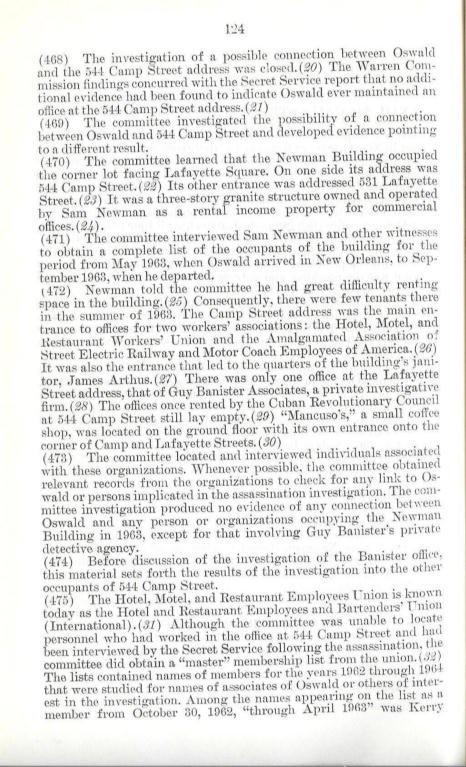







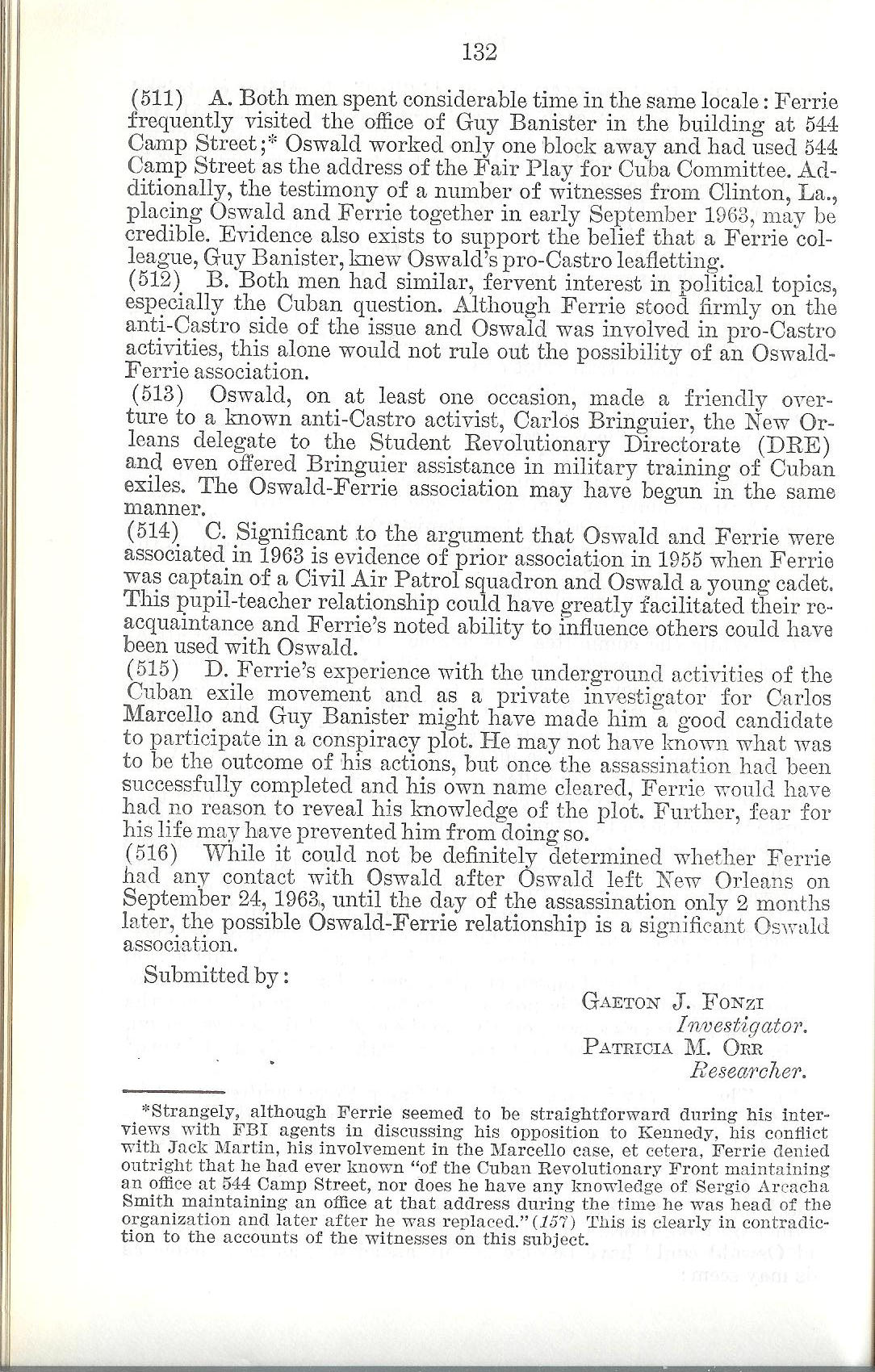

I can be reached for Questions, Comments, Files Transfers or, Clarifications at the following e-mail address.


